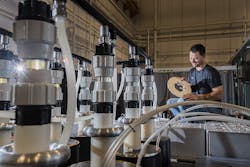Pressure: The Key to Quicker Nanowires?
Researchers at Sandia National Laboratory turned up the gain on a common industrial procedure, embossing, to create a new process, stress-induced fabrication, which can be used to quickly make arrays of nanowires and other nano-sized components. They recently successfully used the process to make nanowire arrays similar to those that underlie the surfaces of touchscreens for sensors, computers, phones, and TVs.
Traditional chemistry-based techniques used to make the arrays take hours; the pressure-based method needed less than a second (or one nine-millionth of the time chemical processes need). The Sandia team had the luxury of having access to Veloce, a pulsed-power machine developed at Sandia that can generate pressures on the order of 100,000 atmospheres.
The researchers say that less exotic machines, such as those used for embossing credit cards, could be converted to using the new process. An earlier version of stress-induced fabrication was explored, but it relied on a hand-tightened vise with diamond anvils to supply the pressure. It was not quick enough or controllable for commercial production. Embossing machines, however, should overcome these limitations.
If so, the process would offer several benefits. It would save time, fabricating useful nanostructures in seconds instead of hours. It would use fewer materials because only the exact amount of materials are needed. There is no scrap or waste. It would protect the environment because there are no chemicals to dispose of or possible leak. And there would be fewer defects in the finished products.

